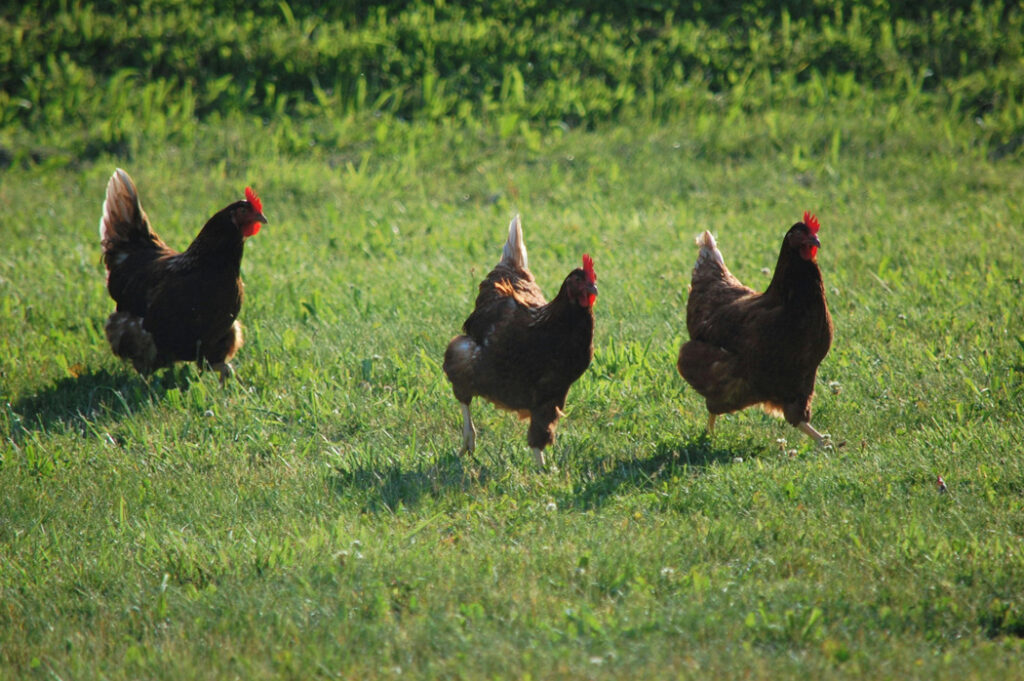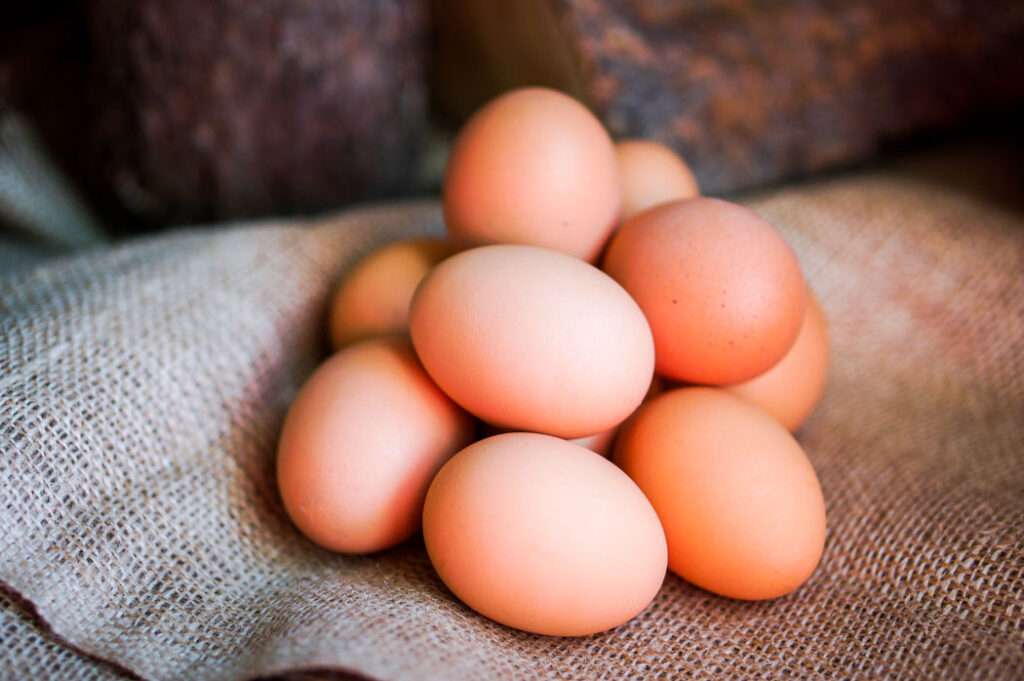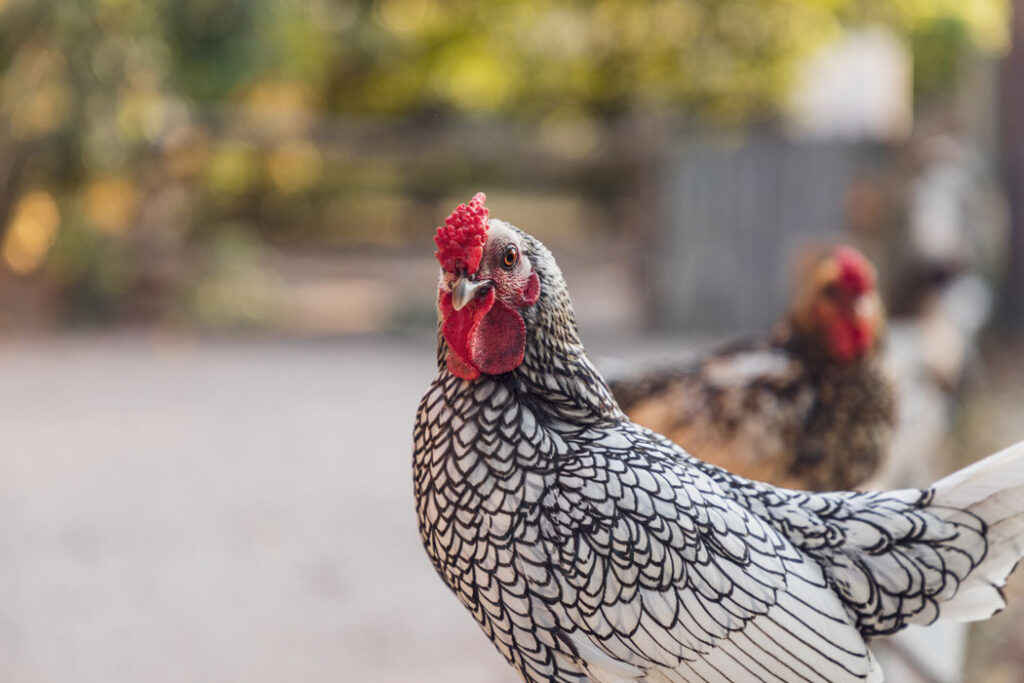
“How many pets put themselves to bed at night?” Andrew Edlin asked rhetorically. He certainly knows that the answer is “just chickens,” since this Fairfield real estate agent has had hens in his backyard for 18 years. (He refers to the four who remain as “pensioners,” since they are past their laying years.) Years ago, if his daughter Holly didn’t come and lock the coop at dusk, the top-of-pecking-order hen “Housey” would fearlessly trot over to the back step, complaining loudly and tapping her beak against the glass door to remind her young owner of the flock’s security needs.
Such is the entertainment value of backyard chickens.
A Dozen Eggs, A Dozen Benefits
Add that benefit to control of garden insects, consumption of kitchen scraps, generation of nitrogen-rich fertilizer, and the gift of an egg nearly every day, and many Iowa families are adding chickens to the view out their kitchen window. Bestselling books like Barbara Kingsolver’s Animal, Vegetable, Miracle and Michael Pollan’s In Defense of Food: An Eater’s Manifesto have spurred interest in eating locally and knowing those who raise our food.

Keeping small flocks of laying hens is on the rise for the first time since the Victory Gardens of WWII. Some like the bright orange yolks that mean these eggs are full of vitamin A and lower in cholesterol because of the hen’s varied diet and more active lifestyle. Others get jazzed up about finding a protein source that does not depend on fossil fuels. Some remember hens from the farms of their youth and want to relive a small piece of that.

Many consumers assume that any carton of eggs labeled cage-free guarantees that the hens were treated well and should be healthy, but the sad reality is that current rules allow any facility with a door to the outside to label eggs “free range,” and most cage-free factories debeak the overcrowded hens so they will not attack each other. Some of the increased interest in local food was probably motivated by last year’s half-billion egg recall from two Iowa egg factories after they were linked to salmonella food poisoning.
Cedar Rapids Joins the Trend
Style and food diva Martha Stewart (who’s raised chickens for 30 years) devoted an hour TV show to the small-flock trend. Sitting in the studio audience of chicken fanciers was Rebecca Mumaw, president of Cedar Rapids Citizens for Legalization of Urban Chickens (CR-CLUC). Rebecca led the year-long drive to have Cedar Rapids modify its city ordinance to allow each licensed family up to six hens. The restrictions cover what the coops can be made out of, require taking a class by Indian Creek Nature Center director Rich Patterson on Basic Intro to Chickens, purchasing a $25 annual license, and placing a metal leg band on each hen.
But Rebecca considers it to be a victory for her polite, patient, and persistent activists in the yolk-yellow “Got Eggs?” T-shirts. Club members kept showing up at council meetings, writing letters to the editor, speaking at community forums, and lobbying lawmakers until they won permission to raise more nutritious food on their own property. Cedar Rapids joins Ames, Madison, Portland, and New York City in allowing city hens.
Ready To Get Started?
1. Find out if your town allows chickens. Call city hall or the animal control department. If the law doesn’t say either way, offer to bring your request before the city council at their next meeting.
2. Hens only? Check with any neighbors with earshot if you plan to include a rooster. While a male is not necessary for hens to have a happy productive life, the rooster does look after the ladies and it is the only way to get fertile eggs to raise your own. However, roosters really will greet the dawn, which comes as early as 5:36 a.m. in this part of the world. Two roosters are guaranteed to demonstrate where the term “cockfight” came from.
3. Build a secure coop. If you just want a couple of hens, there’s an ingenious product called Eglu from Great Britain that is completely self-contained. If you already have a gardening shed or other structure, make sure that it is secure against predators like raccoons and stray dogs. Free designs for a do-it-yourself coop are available online.
Heritage breeds, which lay brown or green eggs, are too heavy to really fly, and chickens are defenseless at night, so be sure that you have more than chicken wire between your flock and a determined fox.

4. Select your chicks. This is the fun part! Most hatcheries ship a minimum of 10 to 30 chicks (depending on the breed) the day they hatch, because they need the group warmth to survive. (It’s hard to believe, but chicks don’t have to eat or drink for the first 24 hours because they are still living off the yolk.) Half the chicks will be male, unless you pay extra for sexed batches.
When looking at breeds, realize that “bantam” means a smaller version of the breed, like a toy poodle. If you have a group to order with, contacting a hatchery is a very affordable option and they frequently offer a bargain if you want to experiment with a “grab bag” exotic breed—including fancy chickens, ducks, and peacocks. If you go to a farmer to buy chicks, then you won’t have that awkward question of what to do with chicks that have started to crow. (Most local breeders will take back the males; just don’t expect a refund.)
TSC, Theisens, and other farm stores carry chicks in the spring. However, they are usually hybrids, intended for maximum laying rather than pleasant personalities. Be careful not to buy meat birds. Because they have been bred to gain weight very quickly, they don’t have strong enough legs to move around much and they rarely live one year.
As multiple Iowa State Fair Ribbon-winner Holly Edlin said of meat birds, “They’re not very smart, even for chickens.”
5. Buy your stuff. Get a heat lamp, feed, and dishes, with plenty of straw or wood chips for bedding. They will want some place to roost and a few nesting boxes. Even three chickens generate enough heat to survive an Iowa winter, but you may want to have a 100-watt incandescent bulb under a flowerpot ready for the really cold nights. Artificial light in the coop will extend egg production into the fall, too.
6. Prepare the nursery. Like with a puppy, lots of newspaper is a good idea, so you can gather it up as it gets messy. Introduce your chicks to water by dipping each beak in the water dish. Start with mash the first few weeks, until their fuzz falls off.
7. Gather eggs daily. Give them some grain and water, plus whatever vegetable scraps that used to go down your garbage disposal. If the birds spend a lot of time in the coop, you’ll want to change bedding once per week, but a moveable chicken tractor (a bottomless, portable pen) gets around that chore and spreads that wonderful fertilizer while the hens eat your bugs.
8. Enjoy humankind’s easiest livestock.
Resources
Murray McMurray. Billing themselves as the “World’s Rare Breed Poultry Headquarters,” this Webster City, IA, hatchery has hundreds of breeds and ample supply and equipment options. Sign up for free newsletter at www.mcmurrayhatchery.com. (515) 832-3280
My Pet Chicken. These folks in Norwalk, CT, are totally focused on raising chickens as pets—including chicken diapers for visits indoors. Special packages allow them to ship as few as three chicks. Expect higher prices, but they offer lots of information for beginners. Answer the six questions in their Chicken Selection Tool and they will recommend breeds at www.MyPetChicken.com.
County Line Hatchery. If you are willing to drive to Coggin, IA they waive the minimum order for their dozens of heritage breeds and other poultry. This way you get to meet the adults to get a feel for the breed’s temperament. 319-350-6820
Mad City Chickens. This group of determined urban chicken farmers in Madison, WI, created a DVD detailing their struggle to surreptitiously raise chickens while working to legalize urban hens. www.Madcitychickens.com
Also, contact your ISU extension office and 4-H clubs for classes and questions about raising your flock.
